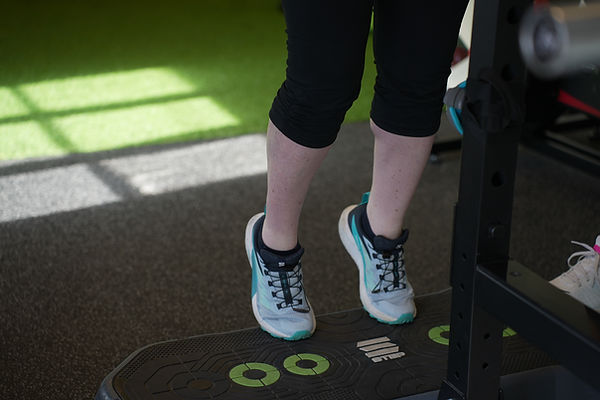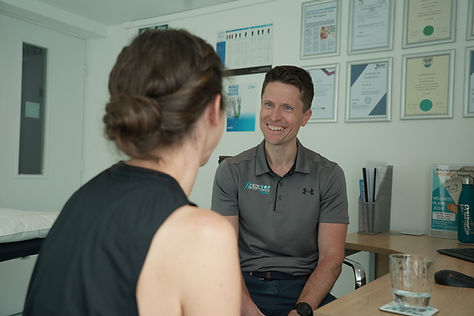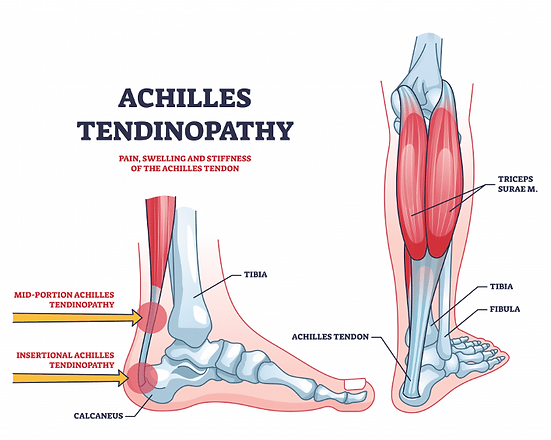
BLOG
Understanding and Managing Insertional Achilles Tendinopathy in Runners:
by Lauren Brown, Sport Rehabilitator and Massage Therapist
Running is an excellent way to stay fit and offers protective benefits against conditions like low back pain (Neason et al., 2024), and hip and knee osteoarthritis (Alentorn-Geli et al., 2017). However, as with any sport, running carries certain risks, with musculoskeletal injuries being among the most common. Achilles tendinopathy, a condition affecting the tendon that connects the calf muscles to the heel bone, is one of the most frequent injuries runners face (Kakouris, Yener and Fong, 2021). Common symptoms include pain, stiffness, and tenderness along the Achilles tendon, particularly in the morning or during activity, along with thickening of the Achilles tendon and impaired performance or loss of training time.
The causes of Achilles tendinopathy are multifactorial. Whilst running, the Achilles tendon can be exposed to up to 8 times body weight (Lee, Ling and Yung, 2019), and this repetitive stress can contribute towards the onset of Achilles tendinopathy. Studies indicate that one in twenty recreational runners will develop this condition, with marathon participants being particularly at risk (Lagas et al., 2020). In this blog, we'll explore the pathophysiology of insertional Achilles tendinopathy, effective management strategies, and tips to help runners recover and prevent future injuries.
What is Insertional Achilles Tendinopathy?
Achilles tendinopathy is categorised into two types based on its location: midportion and insertional. Midportion tendinopathy is more common, making up about two-thirds of cases (Chen et al., 2023). Unlike the more common mid-portion Achilles tendinopathy, insertional Achilles tendinopathy affects the tendon’s attachment point at the heel bone (calcaneus), causing pain in the lower part of the tendon.
While both conditions share similar rehabilitation strategies, a key distinction in managing insertional Achilles tendinopathy is the focus on adjusting the compressive forces applied to the tendon. Dorsiflexion, the movement of pointing the toes upward, increases tendon compression, which is a key factor in insertional Achilles tendinopathy. Repeated compression can aggravate the tendon, leading to further discomfort and degeneration. This explains why runners often experience significant pain when running uphill and highlights the importance of managing compressive forces in treatment.
Management of Insertional Achilles Tendinopathy...
Effective management of insertional Achilles tendinopathy requires a holistic, individualised approach. Key components include pain relief, load management, and targeted strengthening.
-
Non-steroidal anti-inflammatory drugs (NSAIDs), like ibuprofen, can help manage pain in the early (reactive) stage of tendinopathy (Goom, 2013). However, prolonged NSAID use may impair tendon healing (Su & O’Connor, 2013) and carries risks such as kidney injury and gastrointestinal bleeding, especially in long-distance runners (Pannone & Abbott, 2024). As such, NSAIDs should be used cautiously and strictly according to the instructions. Furthermore, Topical NSAIDs (eg, ibuprofen gel) can be considered a viable alternative to oral NSAIDs, as they are considered to be similarly effective and are associated with fewer side effects (Klinge and Sawyer, 2013).
-
Alternatively, Extracorporeal Shockwave Therapy (ESWT) has been shown to be a beneficial adjunct treatment for individuals living with Achilles tendinopathy, helping to reduce symptom severity and improve overall function (Li et al., 2023). ESWT effectively alleviates pain, enhances tendon healing, and supports recovery by stimulating cellular regeneration and increasing blood circulation in the affected area. This non-invasive therapy is particularly useful for patients who have not responded well to conventional treatments, or those looking to decrease the time taken to return to sport (Morgan et al., 2021). Moreover, ESWT is recommended by the National Institute for Health and Care Excellence (2016) in their guidance for the management of insertional and mid-portion Achilles tendinopathy.
-
Isometric exercises, which involve holding a static position without changing muscle length, are especially beneficial during the reactive stage of rehabilitation. They help maintain strength while also providing a pain-relieving effect, promoting healing without additional symptom provocation (Cook and Purdam, 2013).
Load management:
Load management is achieved by minimising tendon compression and reducing tensile force. To minimise compression, avoid calf stretches and use massage to relieve stiffness, limit dorsiflexion during tendon-loading exercises, and using heel lifts during daily activities (Pringels et al., 2025). To reduce tensile force, runners should adjust their distance, gait, and terrain under the guidance of a qualified healthcare professional.
Rehabilitation
The primary goal of rehabilitation for insertional Achilles tendinopathy is to strengthen the tendon and surrounding tissues so they can effectively manage load without exacerbating symptoms. Recent research by Pringels et al. (2025) highlights the importance of minimising tendon compression during rehabilitation. Their study found that a low-compression tendon-loading program (pictured below) was more effective than a high-compression approach in reducing pain and improving function among 38 sport-active individuals with insertional Achilles tendinopathy.
The findings suggest that a structured 12-week progressive loading program - designed to carefully limit dorsiflexion during exercise and daily activity (with the use of a heel lift), while incorporating patient education, and soft tissue massage - offers the most effective strategy for managing symptoms. This structured approach - focusing on controlled loading while minimising tendon compression - optimises recovery outcomes.
Key Advice for Runners
Prevention is better than a cure. Here are some practical tips for runners to reduce the risk of insertional Achilles tendinopathy:
✅ Strengthen your lower limbs – Incorporate strength training several times a week, focusing on your calves, feet, and surrounding muscles to improve tendon resilience.
✅ Progress gradually – Avoid sudden increases in mileage, intensity, or terrain difficulty to prevent excessive strain on the Achilles tendon.
✅ Always warm up – A proper warm-up prepares your muscles and tendons for the demands of running, reducing injury risk.
✅ Wear the right footwear – Choose running shoes that provide adequate support and are suited to your foot mechanics and running style.
✅ Listen to your body – If you experience persistent discomfort in your Achilles or heel, seek professional advice early to prevent symptoms from worsening.
Conclusion...
Insertional Achilles tendinopathy can be a frustrating injury, keeping you from the sport you love. However, with the right management and a structured rehabilitation plan, most runners can make a full recovery.
Early intervention - focused on pain relief, load management, and targeted strength training - is key to reducing symptoms and preventing recurrence. If you're experiencing persistent Achilles pain, don’t hesitate to reach out to us at Prime Performance Physiotherapy. We're here to help you get back on track.
Reference list...
Alentorn-Geli, E., Samuelsson, K., Musahl, V., Green, C.L., Bhandari, M. and Karlsson, J. (2017). The Association of Recreational and Competitive Running With Hip and Knee Osteoarthritis: A Systematic Review and Meta-analysis. The Journal of orthopaedic and sports physical therapy, [online] 47(6), pp.373–390.
Chen, W., Cloosterman, K.L.A., Bierma-Zeinstra, S.M.A., van Middelkoop, M. and de Vos, R.-J. (2023). Epidemiology of insertional and midportion Achilles tendinopathy in runners: A prospective cohort study. Journal of Sport and Health Science, [online] 13(2).
Goom, T. (2013). Insertional Achilles Tendinopathy. [online] RunningPhysio. Available at: https://www.running-physio.com/insertional-achilles-tendinopathy/.
Kakouris, N., Yener, N. and Fong, D.T.P. (2021). A systematic review of running-related musculoskeletal injuries in runners. Journal of Sport and Health Science, 10(5).
Klinge, S.A. and Sawyer, G.A. (2013). Effectiveness and Safety of Topical versus Oral Nonsteroidal Anti-inflammatory Drugs: A Comprehensive Review. The Physician and Sportsmedicine, 41(2), pp.64–74.
Lagas, I.F., Fokkema, T., Verhaar, J.A.N., Bierma-Zeinstra, S.M.A., van Middelkoop, M. and de Vos, R.-J. (2020). Incidence of Achilles tendinopathy and associated risk factors in recreational runners: A large prospective cohort study. Journal of Science and Medicine in Sport, 23(5), pp.448–452.
Lee, K.K.W., Ling, S.K.K. and Yung, P.S.H. (2019). Controlled trial to compare the Achilles tendon load during running in flatfeet participants using a customized arch support orthoses vs an orthotic heel lift. BMC Musculoskeletal Disorders, 20(1).
Li, H., Yao, W., Xue, X., Li, Y., and Hua, Y. (2023) Therapeutic effects following extracorporeal shock wave therapy for insertional and non-insertional Achilles tendinopathy. Asia-Pacific Journal of Sports Medicine, Arthroscopy, Rehabilitation and Technology.
Morgan, J.P.M., Hamm, M., Schmitz, C. and Brem, M.H. (2021). Return to play after treating acute muscle injuries in elite football players with radial extracorporeal shock wave therapy. Journal of Orthopaedic Surgery and Research, 16(1).
National Institute for Health and Care Excellence. (2016) Extracorporeal shockwave therapy for Achilles tendinopathy Interventional procedures guidance Your responsibility Your responsibility. (2016). Available at: https://www.nice.org.uk/guidance/ipg571/resources/extracorporeal-shockwave-therapy-for-achilles-tendinopathy-pdf-1899872103152581.
Neason, C., Samanna, C.L., Tagliaferri, S.D., Belavý, D.L., Bowe, S.J., Clarkson, M.J., Craige, E.A., Gollan, R., Main, L.C., Miller, C.T., Mitchell, U.H., Mundell, N.L., Scott, D., Tait, J.L., Vincent, G.E. and Owen, P.J. (2024). Running is acceptable and efficacious in adults with non-specific chronic low back pain: the ASTEROID randomised controlled trial. British Journal of Sports Medicine, p.bjsports-108245.
Pannone, E. and Abbott, R. (2024). What is known about the health effects of non-steroidal anti-inflammatory drug (NSAID) use in marathon and ultraendurance running: a scoping review. BMJ Open Sport & Exercise Medicine, 10(1), pp.e001846–e001846.
Pringels, L., Robbe Capelleman, Van, Arne Burssens, Guillaume Planckaert, Evi Wezenbeek and Luc Vanden Bossche (2025). Effectiveness of reducing tendon compression in the rehabilitation of insertional Achilles tendinopathy: a randomised clinical trial. British Journal of Sports Medicine, p.bjsports-109138.
Su, B. and O’Connor, J.P. (2013). NSAID therapy effects on healing of bone, tendon, and the enthesis. Journal of Applied Physiology, 115(6), pp.892–899.












